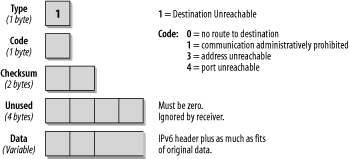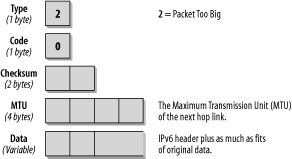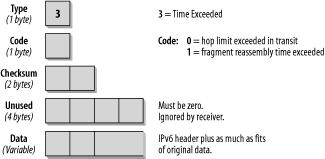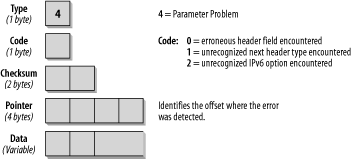Every ICMP message can have a slightly different header depending on the kind of error report or information it carries. The following sections outline the structure of each type of ICMPv6 message.
A Destination Unreachable message is generated if an IP datagram cannot be delivered. A Type field with the value 1 identifies this message. The ICMP message is sent to the source address of the invoking packet. The format of the Destination Unreachable message is shown in Figure 4-2.
The Type field is set to one, which is the value for the Destination Unreachable message. The Code field supplies more information about the reason why the datagram was not delivered. The possible codes are listed in Table 4-3. The data portion of the ICMP message contains parts of the original message—as much as will fit into the ICMP message.
Table 4-3. Code values of the Destination Unreachable message (type 1)
|
Code |
Description |
|---|---|
|
0 |
No route to destination This message is generated if a router cannot forward a packet because it does not have a route in its table for a destination network. This can only happen if the router does not have an entry for a default route. |
|
1 |
Communication with destination administratively prohibited This type of message can, for example, be sent by a firewall that cannot forward a packet to a host inside the firewall because of a packet filter. It might also be sent if a node is configured not to accept unauthenticated Echo Requests. |
|
2 |
Beyond scope of source address This code is used when the multicast scope of the source address is smaller than the scope of the destination address. This code is a draft at the time of writing (http://www.ietf.org/internet-drafts/draft-ietf-ipngwg-icmp-v3-02.txt). |
|
3 |
Address unreachable This code is used if a destination address cannot be resolved into a corresponding network address or if there is a data-link layer problem preventing the node from reaching the destination network. |
|
4 |
Port unreachable This code is used if the transport protocol (e.g., UDP) has no listener and if there is no other means to inform the sender. For example, if a Domain Name System (DNS) query is sent to a host and the DNS server is not running, this type of message is generated. |
If the destination is unreachable due to congestion, no ICMP message is generated. A host that receives a Destination Unreachable message must inform the upper-layer process.
If a router cannot forward a packet because it is larger than the MTU of the outgoing link, it will generate a Packet Too Big message (shown in Figure 4-3). This ICMPv6 message type is used as part of the Path MTU discovery process discussed later in this chapter. The ICMP message is sent to the source address of the invoking packet.
The Type field has the value 2, which identifies the Packet Too Big message. In this case, the Code field is not used and is set to zero. The important information for this type of message is the MTU field, which contains the MTU size of the next hop link.
RFC 2463 states that an ICMPv6 message should not be generated as a response to a packet with an IPv6 multicast destination address, a link-layer multicast address, or a link-layer broadcast address. The Packet Too Big message is an exception to this rule. Because the ICMP message contains the supported MTU of the next hop link, the source host can determine the MTU that it should use for further communication. A host that receives a Packet Too Big message must inform the upper-layer process.
When a router forwards a packet, it always decrements the hop limit by one. Remember, the hop limit makes sure that a packet does not endlessly travel through a network. If a router receives a packet with a hop limit of one and decrements the limit to zero, it discards the packet, generates a Time Exceeded message with a code value of zero, and sends this message back to the source host. This error can indicate a routing loop or the fact that the sender’s initial hop limit is too low. It can also tell you that someone used the traceroute utility, which is described later in the chapter. Figure 4-4 shows the format of the Time Exceeded message.
The Type field carries the value 3, specifying the Time Exceeded message. The Code field can be set to 0, which means hop limit exceeded in transit, or to 1, which means that the fragment reassembly time is exceeded. The data portion of the ICMP message contains parts of the original message—as much as fits into the ICMP message, depending on the MTU used.
An incoming Time Exceeded message must be passed to the upper-layer process. Table 4-4 shows the Code fields for the Time Exceeded message.
Table 4-4. Code values for Time Exceeded message (type 3)
|
Code |
Description |
|---|---|
|
0 |
Hop limit exceeded in transit. Possible causes: the initial hop limit value is too low, or there are routing loops. |
|
1 |
Fragment reassembly time exceeded. If a fragmented packet is sent by using a fragment header (refer to Chapter 2 for more details) and the receiving host cannot reassemble all packets within a certain time, it notifies the sender by issuing this ICMP message. |
The hop limit exceeded in transit message type is commonly used to do the traceroute function. Traceroute is helpful in determining the path that a packet takes when traveling through the network. In order to do this, a first packet is sent out with a hop limit of one. The first router in the path decrements the hop limit to zero, discards the packet, and sends back an ICMP message type three, code zero. The source host now knows the address of the first hop router. Next, it sends out a second packet with a hop limit of two. This packet is forwarded by the first router, which decrements the hop limit to one. The second router in the path decrements the hop limit to zero, discards the packet, and sends back an ICMP message type three, code zero. Now the source knows about the second router in the path. Raising the hop limit by one (with every packet sent until the packet reaches the final destination) continues this process. Every router in the path to the final destination sends an ICMP message back to the source host, thereby providing its IP address. It is important to know that if there are redundant paths to the destination, traceroute does not necessarily show the same route for all tests because it might choose different paths.
If an IPv6 node cannot complete the processing of a packet because it has a problem identifying a field in the IPv6 header or in an Extension header, it must discard the packet and it should send an ICMP Parameter Problem message back to the source of the problem packet. This type of message is often used when an error that does not fit into any of the other categories is encountered. The format of this ICMP message is shown in Figure 4-5.
The Type field has the value 4, which specifies the Parameter Problem message. The Code field can contain any of the three values described in Table 4-5. The Pointer field identifies at which byte in the original packet the error was detected. The ICMP message includes as much of the original data as fits up to the minimum IPv6 MTU. It is possible that the pointer points beyond the ICMPv6 message. This would be the case if the field in error was beyond what can fit in the maximum size of an ICMPv6 error message.
Table 4-5 shows the Code fields for the Parameter Problem message.
For example, if you see an ICMPv6 message of type 4 with a code value of 1 and a pointer set to 40, this indicates that the next header type in the header following the IPv6 header was unrecognized.
Get IPv6 Essentials now with the O’Reilly learning platform.
O’Reilly members experience books, live events, courses curated by job role, and more from O’Reilly and nearly 200 top publishers.





